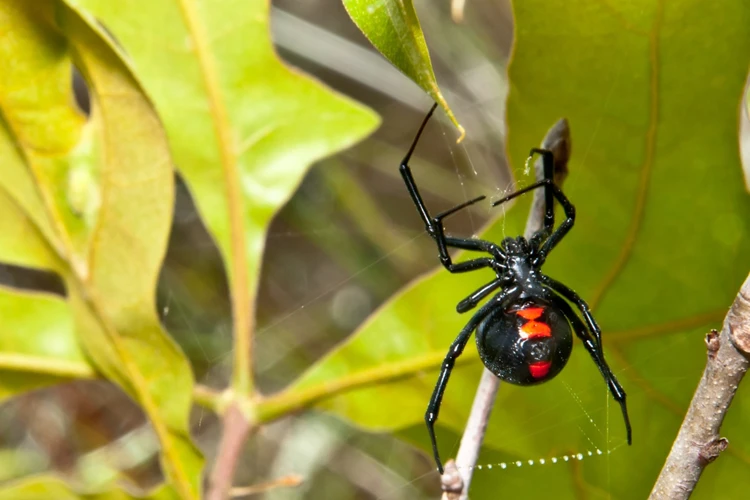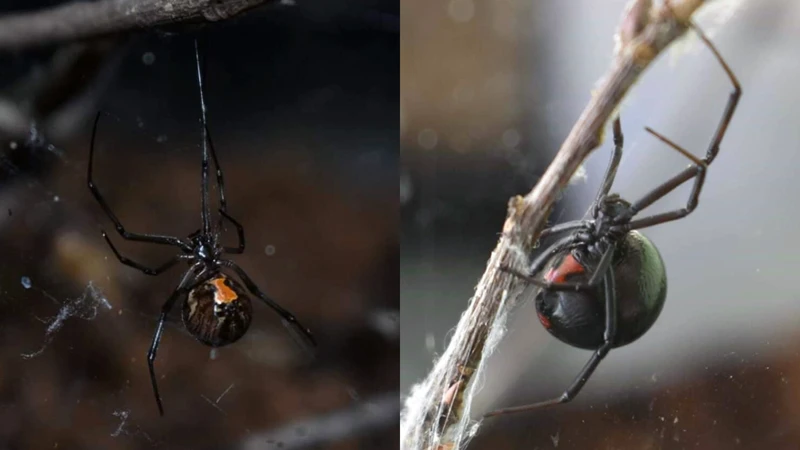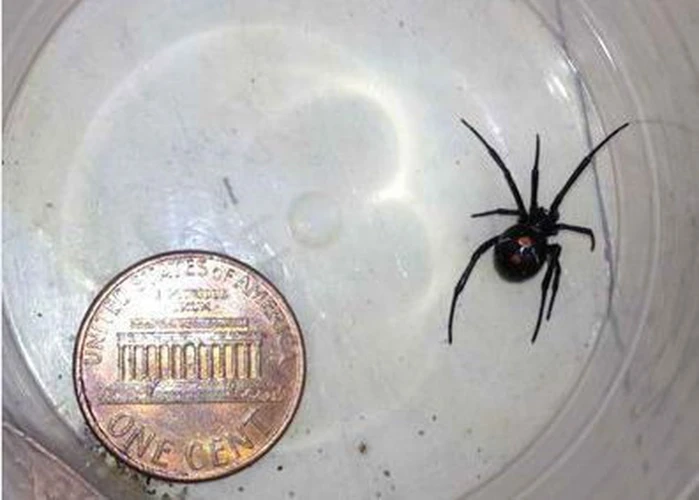As nature lovers, it’s fascinating to see how different species interact with each other in their surroundings. However, it can sometimes be unnerving when we come face to face with a species that poses a potential threat to us, such as the black widow spider. These venomous creatures are notorious for their deadly bites, and encountering them in their territory can be a perilous situation. In this article, we will delve into the consequences that occur when two black widow spiders meet in their territories. Additionally, we’ll provide ways to avoid such situations and protect yourself from these dangerous arachnids. So let’s get started and learn more about this intriguing yet unsettling topic.
Understanding Black Widow Spiders

Black Widow Spiders are known for their venomous bites and the infamous red hourglass shape on their abdomen, which serves as a warning to potential predators. However, these arachnids are much more than just their markings. Understanding Black Widow Spiders includes their appearance, life cycle, and behavioral patterns. As territorial creatures, they have a complex social structure, which plays a role in their survival. To survive and thrive in their habitats, these spiders navigate through various encounters that may have dire consequences. Let’s dive into the fascinating world of Black Widow Spiders. To learn more about Black Widow Spiders’ territorial behavior, read Black Widow Spider Territory.
Appearance and Life Cycle of Black Widow Spiders
The appearance and life cycle of black widow spiders are fascinating. Black widows are shiny, jet black spiders with an hourglass-shaped mark on their abdomen, usually in red or orange color that makes them instantly recognizable. They are also one of the most venomous spiders in the world, with venom that can cause muscle aches, spasms, and breathing difficulties in humans.
Black widows are sexually dimorphic, with females being the largest and most dangerous with their venomous bites. Females can measure up to 13 mm in body length, while males measure up to 6 mm. The females also outlive the males, with a lifespan of up to three years, while males only live for a few months once they reach maturity.
These spiders go through a life cycle that involves hatching from eggs and undergoing a molting process as they grow. Black widows typically lay their eggs in clusters, and each cocoon can contain hundreds of baby spiders. The spiderlings hatch in about 20 days and stay with their mother until they reach their first molting stage.
During the molting process, the spider sheds its exoskeleton and grows a new one. Black widow spiders molt six to nine times before reaching maturity. They reach sexual maturity at around three months old for males and seven or eight months for females.
It’s worth noting that the behavior and life cycle of black widow spiders are closely linked to their territorial behavior, which can lead to conflicts and even cannibalism in some cases. To learn more about black widow territorial behavior, visit territorial conflicts in black widow spiders.
Behavioral Patterns of Black Widow Spiders
Black Widow spiders are known for their distinctive behavior patterns, which makes them stand out from other spider species. Here are some of their behavioral patterns which are worth highlighting:
- Mating and Reproduction: One of the most notable behavioral patterns of Black Widow spiders is their tendency to mate for life. After mating with a female, a male spider often dies, which leaves the female to mate with other males. This process can create territorial disputes among the females, especially during the breeding season when they compete for resources and mates. You can read more about it in our previous article on Black Widow Spider territoriality and reproduction.
- Cannibalism: Another interesting behavioral pattern of Black Widow spiders is their tendency to practice cannibalism. Females, in particular, are known to eat their male counterparts after mating. However, research has also shown that females may also eat other female spiders who come into their territories. For more information on the consequences of two Black Widow spiders meeting, check out our article about the consequences of two Black Widow spiders meeting in their territories.
- Web building and communication: Black Widow spiders are also known for using their silk to build webs and communicate with other spiders. They use their webs both for catching prey and for creating shelter. They also use their silk for communication, which helps them to locate potential mates and warn off rivals. If you want to learn more about Black Widow territorial behavior, including how they communicate, check out this article about Black Widow territorial behavior.
- Aggressive and Territorial: Black Widow spiders are regarded as creepy and dangerous due to their highly aggressive and territorial behavior. They are known to bite when provoked or when they feel threatened by humans or other animals. This behavior makes them a concern for people who live in areas where they are common. To learn more about how to avoid a Black Widow spider encounter, we have put together an article about Black Widow spider territory and behavior.
- Size and Behavior of juveniles: Lastly, even juvenile Black Widow spiders exhibit unique behavioral patterns such as advanced hunting techniques. Despite their small size, juvenile spiders are highly capable of hunting down and trapping prey. This ability is rooted in their behavioral patterns, which unlike adult spiders, are primarily driven by feeding and survival instincts. To learn more about juvenile Black Widow spiders’ behavior, check out our article on Black Widow juvenile behavior.
The behavioral patterns of Black Widow spiders are a fascinating subject. Their territoriality, communication, cannibalism, aggression, and web-building techniques are what make them such a unique species of spider.
The Consequences of Two Black Widow Spiders Meeting

As fascinating as they might be, encountering black widow spiders is not an experience most people would relish. These spiders are known for their potentially lethal venom, and when two meet, the consequences can be quite significant. Depending on the situation, two black widow spiders coming face to face can lead to anything from cannibalism to mating or fighting. Understanding the reasons behind spider disputes and the possible outcomes of these encounters can help you stay safe around these venomous arachnids. To learn more about black widow behavior, check out our previous article on black widow territorial behavior.
Reasons for Spider Disputes – Mating Season and Territories
Black widow spiders have a well-established hierarchical territorial system, which is ruled by a dominant, usually larger female spider. The primary struggle for resources in their habitat is for finding sufficient food and surviving without becoming prey. Inevitably, territories are set up to help balance the predator-prey relationship. However, territories are limited. If another black widow spider infringes on an established territory, a dispute may arise.
There are two primary reasons for black widow spider disputes – mating season and territories. During the mating season, male black widows will often enter a female spider’s habitat, and if caught, will need to undergo the stress of mating or escape. This stress can lead to a fight between the male and female spiders.
In contrast, territorial disputes usually involve a larger and more aggressive female black widow spider trying to defend her territory from another black widow spider. When a female spider detects the presence of another spider, she will become highly agitated and aggressive. In some extreme cases, the spiders may engage in lethal combat in order to secure their territories.
It is worth noting that black widow spiders are not naturally aggressive and that human activity can play a role in influencing their behavior. For example, construction work or renovations in houses or nearby areas can disrupt their natural habitat, and they may become more aggressive as a result.
Territorial disputes among black widow spiders are typically driven by their need for resources and are often a result of either defending a territory or finding a mate. These disputes can have deadly consequences, and it is best to take measures to avoid encounters with these highly venomous spiders. You can learn more about black widow spider territorial behavior by checking out a comparison with their relatives or by understanding how human activity influences black widow behavior.
Possible Scenarios of Confrontation – Cannibalism, Mating, and Fighting
Possible Scenarios of Confrontation:
Black widows are known to be solitary creatures, preferring to live and hunt alone. However, during mating season or territorial disputes, two black widow spiders may come face to face, resulting in several possible scenarios of confrontation. These scenarios include cannibalism, mating, and fighting.
1. Cannibalism: When two black widows meet, it’s not uncommon for one spider to attack and consume the other. This is especially true if one spider is hungry or if there are limited resources in the area. The larger spider will often overpower the smaller one, injecting it with venom and then wrapping it up in a silk cocoon before consuming it. Cannibalism often occurs when the spiders are of opposite sexes and have no interest in mating.
2. Mating: When two black widows meet during mating season, the interaction can be quite different. Male black widows will often approach females in order to mate. However, mating can be dangerous for the male, as the female may become aggressive and attempt to kill him. This is because female black widows are much larger and stronger than males, and they require a lot of energy to produce eggs. They may see the male as a potential meal rather than a mate.
3. Fighting: In some cases, black widow spiders may engage in physical combat if they feel threatened by the presence of another spider. This is often the case if two spiders are of the same sex and are competing for the same resources or territory. The spiders will rear up on their hind legs and try to intimidate each other by showing off their fangs and venom glands. If physical contact is made, the spiders may bite each other and inject venom, which can be deadly. However, fighting between black widow spiders is relatively rare, as they typically avoid confrontation when possible.
Understanding the possible scenarios of confrontation between black widow spiders is important for several reasons. Not only does it shed light on the territorial behavior of these creatures, but it also highlights the potential danger they pose to humans. By understanding the behaviors of black widow spiders, we can take steps to avoid encounters and protect ourselves from their poisonous bites. For more information about spider territorial behavior and comparison with other species, check out our article about spider territorial behavior comparison. Additionally, understanding how human activity can affect black widow behavior is crucial in minimizing the risk of bites and encounters. This is covered in more detail in our article about human activity and black widow behavior.
How to Avoid Black Widow Spider Encounters
It’s understandable that encountering a black widow spider can be quite unnerving. These spiders possess a venom that is harmful to humans, and their presence can be a cause for concern. To avoid getting bitten by a black widow spider, it’s important to learn some tips and tricks for keeping them away from your home and property. In this section, we’ll discuss some effective ways of keeping these spiders at bay and minimizing your chances of encountering them.
Controlling Spider Populations Around Your House and Yard
Controlling spider populations around your house and yard is crucial to preventing encounters with black widow spiders. Here are some effective methods you can use to keep spiders away:
- Seal off Entry Points: Spiders can enter through small openings and cracks around windows, doors, vents, and pipes. Seal off these areas using caulk or weather stripping to prevent spiders from coming inside.
- Reduce Clutter: Spiders love to hide in piles of clutter, so it’s important to keep your home and yard tidy. Get rid of any unnecessary items and organize your belongings to reduce hiding spots.
- Keep Your Yard Clean: Remove any debris, such as leaves, woodpiles, and branches, from your yard. These materials provide the perfect hiding and breeding grounds for spiders.
- Use Spider Repellents: There are many natural and chemical spider repellents available. For example, peppermint oil, vinegar, and citrus sprays are effective natural repellents. However, keep in mind that repellents are not always 100% effective, and some spiders may be unaffected by them.
- Install Screens: Install screens on windows, doors, and vents to prevent spiders from getting inside. Be sure to check for any holes or tears in screens and repair them promptly.
- Use Pesticides: Pesticides can be effective in controlling spider populations, but they should be used only as a last resort. If you choose to use pesticides, be sure to follow the instructions carefully and use them in areas where spiders are most likely to be hiding.
- Call a Professional: If you have a severe spider infestation or are unable to control spider populations on your own, consider calling a professional pest control company. They have the expertise and tools needed to effectively eliminate spiders from your home and yard.
By taking these measures, you can significantly reduce the chances of encountering black widow spiders in and around your home.
Protective Measures You Can Take When Going Outdoors
When going outdoors, it is important to take necessary precautions to avoid encounters with black widow spiders. Here are some protective measures you can take:
| Protective Measure | Description |
|---|---|
| Wear Protective Clothing | Wear long-sleeved shirts, long pants, and closed-toe shoes when spending time outdoors. |
| Shake Out Clothing and Shoes | Before putting on clothing or shoes that have been sitting outside, shake them out to dislodge any spiders that may be hiding inside. |
| Use Insect Repellent | Apply insect repellent containing DEET to exposed skin to prevent black widow spiders or other insects from crawling on you. |
| Inspect Your Surroundings | Before sitting down or reaching into the dark corners of your surroundings, take a few moments to inspect them for any signs of spiders. |
| Stay Alert | Pay close attention to your surroundings and be aware of any spider webs or spiders you may encounter. |
These protective measures can significantly reduce your chances of encountering black widow spiders when outdoors. It is important to stay vigilant and take precautions to ensure a safe and enjoyable outdoor experience.
Conclusion
As fascinating as black widow spiders may be, encountering them in their natural habitats or even in our own homes can be dangerous. We’ve learned that the consequences of two black widow spiders meeting in their territories can lead to aggressive behavior, such as cannibalism, fighting, and mating. While these spiders may be important for controlling insect populations, it’s important to take precautions to avoid encounters with them.
With a better understanding of black widow spiders, we can take measures to stay safe. This includes controlling spider populations around our homes and being mindful of our surroundings when we go outdoors. By taking simple protective measures, such as wearing long-sleeved clothing, gloves, and boots, we can reduce the risk of being bitten by a black widow spider.
Overall, by being aware of the dangers posed by black widow spiders, we can enjoy the beauty of these creatures from a safe distance. Whether we appreciate them in the wild or in the controlled environment of a zoo or museum exhibit, we can continue to learn more about black widow spiders and their role in our ecosystem. Remember, while they may be fascinating, they should always be treated with caution and respect.
Frequently Asked Questions
What do black widow spiders look like?
Black widow spiders are usually shiny black and have a round abdomen with a red or orange hourglass-shaped marking on their underside.
What is the life cycle of a black widow spider?
Black widow spiders typically live for about a year and females can produce multiple egg sacs during their lifetime. Eggs hatch into spiderlings, which undergo several molts before becoming adults.
Are black widow spiders dangerous?
Yes, black widow spiders are venomous and their bites can cause serious symptoms such as muscle pain, cramps, and sweating. Seek medical attention if bitten by a black widow spider.
What are the common behavioral patterns of black widow spiders?
Black widow spiders tend to be solitary and territorial, with females being larger and more aggressive towards males. They are nocturnal and prefer dark, secluded areas.
What causes disputes between black widow spiders?
Disputes between black widow spiders often occur during mating season and when defending their territories. Males may encounter aggressive females who see them as potential prey instead of mating partners.
What are the possible scenarios when two black widow spiders meet?
Two black widow spiders may engage in cannibalism, mating, or fighting when they meet. The outcome depends on various factors such as the sex, size, and hunger level of the spiders.
How can I control black widow spider populations around my house?
Remove clutter and debris from your yard, seal up any cracks or holes in your home, and use insecticides or natural predators like chickens or guinea fowl to control spider populations.
What are some protective measures I can take when going outdoors?
Wear protective clothing such as long pants and gloves, avoid reaching blindly into dark areas, and be cautious when moving objects where spiders may be hiding.
What is the role of the male black widow spider?
The male black widow spider’s main purpose is to mate with the female, and they often risk being cannibalized during the process.
Are black widow spiders found all over the world?
No, black widow spiders are primarily found in the southern and western parts of the United States, as well as in Central and South America.







